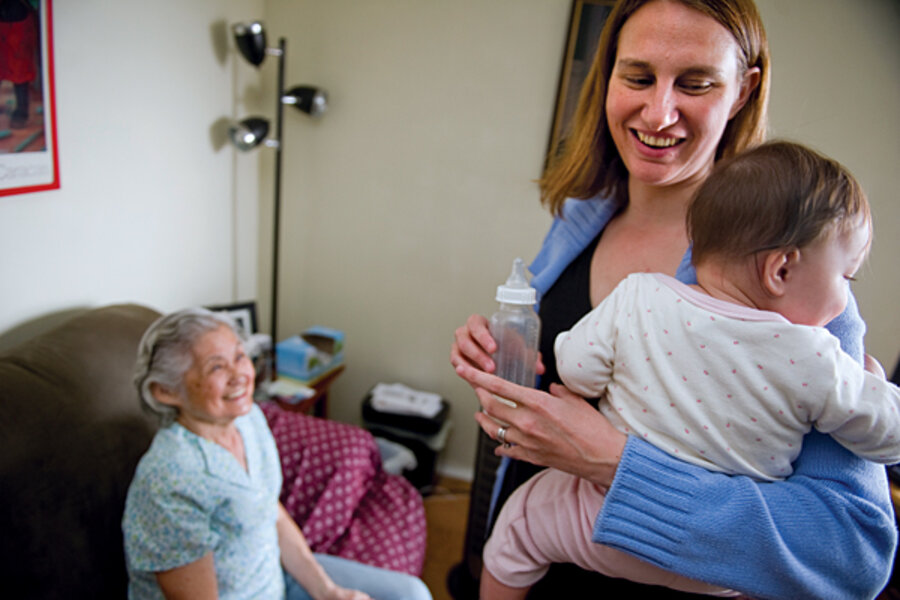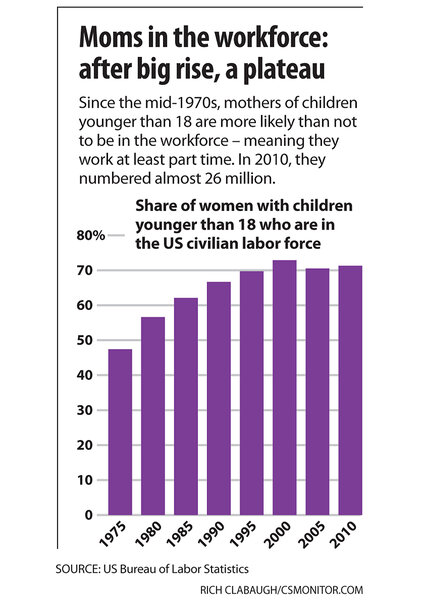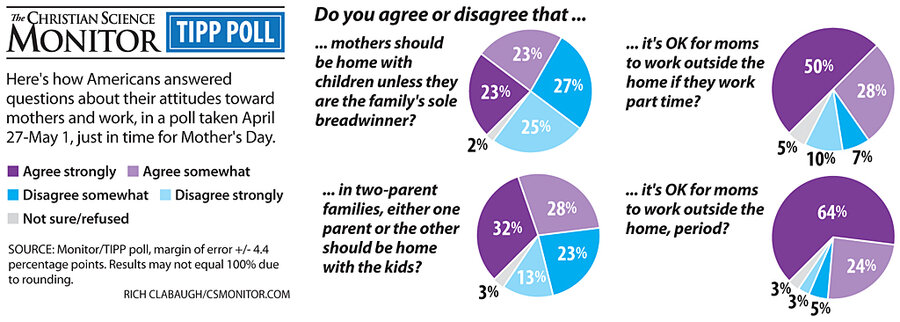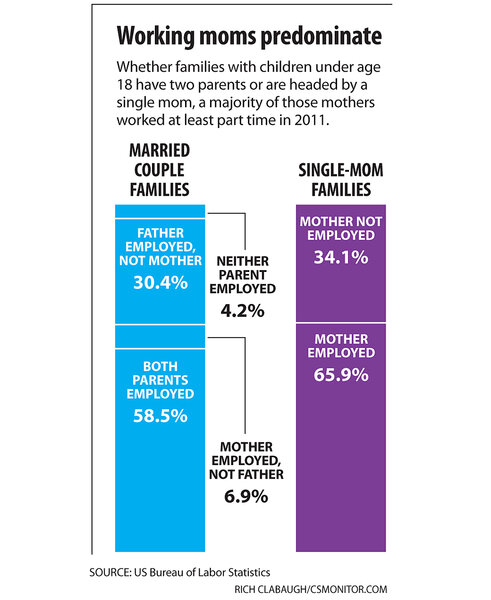Share of working moms nearing all-time high, but has it gotten any easier?
Loading...
What's become clear in the weeks since Democratic strategist Hilary Rosen said Ann Romney "never worked a day in her life" is that the touchy, judgment-passing hostilities of the so-called mommy wars have not ceased to rankle moms of all stripes.
This latest chapter of the mommy wars – which many saw as a smokescreen for more pressing issues affecting working mothers today, such as comparatively low wages and the lack of quality, affordable child care – sees near-record-high shares of mothers in the workforce, some 70.6 percent.
It's been about 40 years since women, freshly liberated by the feminist movement, began entering the workforce in droves. Four decades later, has it gotten any easier?
For Judith Sornberger, a divorced mother raising twin boys solo in the 1970s, working motherhood was a daily struggle. Though she worked full time as an administrative assistant, Ms. Sornberger lived below the poverty level.
"Those were rough times," Sornberger says. "I remember having to take my sick leave to stay home and care for [my boys], and because I had very little leave, I would go to work sick."
Sornberger went on to remarry and attend college, and is now a professor and director of the Women's Studies program at Mansfield University in Mansfield, Pa. Thirty years later, the world is no longer such a lonely place for working mothers, she says, citing societal acceptance, more child-care options, and increasing accommodation in the workplace.
"But I have to say," she adds, "in some ways, things are not a lot different for working mothers today."
Nonetheless, many things have changed dramatically for working mothers in the last 40 years. For starters, there are simply many more of them. In 1975 some 47 percent of mothers were in the labor force (defined as working or looking for work), according to the US Bureau of Labor Statistics. That number grew steadily in the '80s and '90s, peaking at almost 73 percent in 2000.
And as the number of women in the workforce swelled, so, too, did their contribution to family incomes. In 1970, a typical wife chipped in about one-quarter of her family's income, or 26.6 percent. By 2010, the median wife's contribution grew to 37.6 percent of her family's income. What's more, nearly 40 percent of working wives now out-earn their husbands, making them the primary breadwinners.
"In the '70s, women in the workforce who were also mothers were pathmakers. They were … breaking ground," says Barbara Risman, professor of sociology at the University of Illinois at Chicago and an executive officer with the Council on Contemporary Families. "Now your average mother is in the workforce. The stigma and revolutionary fervor is behind us, and women today feel they have a right to some workplace flexibility.... That's a really big change."
Of course, things haven't changed for some groups. By and large, black mothers and others from lower-income families have always worked, not because they were pathmakers but because they had to. The greatest change is observed in middle-class, mostly white mothers who elected to join the workforce.
Those moms have reaped the fruits of their foremothers' struggles. Moms like Carrie Wojtaszek, an event and sales manager in Syracuse, N.Y., who never had to hide her pregnancy from her employer, as scores of women before her did, and enjoyed the freedom to use her entire maternity leave. Or Nadia Amin, a Westchester, N.Y., physician whose employer's on-site day care allows her to have lunch with her 3-year-old daughter every day.
"When I had my first baby, there was a big focus on not telling your employer [you were pregnant] until it was painfully obvious, on not taking your full maternity leave," says Leslie Morgan Steiner, editor of "Mommy Wars" and a mom of three who left corporate America to become a writer and public speaker. "Today mothers are more entitled and empowered to advocate for themselves."
The result, says Ms. Steiner, is the prototypical working mom who's juggling sippy cups with legal briefs. "The portrait of a working mother today is a woman who is stretched really thin and who is crazy.... You work like a maniac all day ... then you rush home and have another whole shift with the kids," she says. "It's insanity!"
Herein lies the dilemma: Mothers are an integral part of the workforce, and public opinion has sanctioned this historic change, but, as Steiner's portrait illustrates, society hasn't yet reconciled the challenges inherent in juggling work and motherhood.
So have things gotten easier for working mothers?
"I would say yes," says Sornberger. "But a very qualified yes." For starters, a domestic revolution at home is easing working mothers' burdens. Fathers today spend three times as much time with their children, on average, than their own fathers did, a University of Maryland study found.
Fathers are also doing more housework, about two hours on any given weekday, or 42 minutes more per day on average than in 1977, according to the Families and Work Institute.
Employer accommodations for working moms have also improved markedly since the 1970s. More employers are providing job-protected leave, flexible work schedules, on-site child care, and even breastfeeding rooms. Child-care options have also improved in the past 30 years, says Deirdre Johnston, a professor of communication at Hope College in Holland, Mich.
"The availability of child care has increased, the quality of good child care has improved, and the time structure for child-care options has improved," says Ms. Johnston. "But ... these options are available only for women who can afford it," she adds. "Child care is still very much a two-tiered system."
It's a reality Inshirah Barbour, a home health aide in Syracuse, N.Y., who supports her four children and her husband, a full-time student, knows all too well. Ms. Barbour often works overnight shifts so her husband can watch their kids, or else scrambles to find family members to watch them.
"For me, the easiest thing would be if I had day care where I worked," she says. "It would make a huge difference if I could bring them to work with me."
One of the greatest advances for working parents since the 1970s is the Family and Medical Leave Act. Signed into law under President Bill Clinton in 1993, the federal law requires em-ployers to provide up to 12 weeks of unpaid leave to employees for medical and family needs, including pregnancy, adoption, foster placement, or family illness. And employees can't be fired for requesting or taking leave. Johnston calls it "the most important piece of legislation that has passed in the last 30 years."
That law aside, however, no one has done less for working mothers than the government, say advocates. "The US government has really been the laggard in all Western societies in the construction of formal, governmentally organized child care or family policy," says Ms. Risman.
"A lot of things we say are our values are not in line with the way we spend money as a nation," adds Sornberger. "If we care so much about mothers and children ... why don't we subsidize child care and subsidize maternal and paternal leave?" she asks. "Why don't we offer more part-time and three-quarter-time jobs with benefits?"
That, says Johnston, is just one of a number of challenges working moms continue to face. "Women still take a battering in their careers for motherhood," she says.
The statistics are bruising: Mothers with comparable job experience are 44 percent less likely to be hired than women without children, according to a 2005 study from Cornell University. Even if they are hired, mothers' starting salaries are about $11,000 lower than that of a woman without children. And it gets worse. Mothers tend to earn less and less for each additional child they have, a phenomenon dubbed the "mommy wage gap."
For low-income working mothers, progress has been even slower, says Gloria Thomas, director of the Center for the Education of Women at the University of Michigan, and a single mother of two.
"I don't think we've solved the problem for mothers in low-income and low-skill jobs," she says. "I look at the experiences of my mother, who worked a low-wage job, and I suspect it hasn't gotten any easier for people working those jobs now. We've enjoyed some policies put in place for professional women, but we've got a ways to go to make sure there's equity and opportunity for those who need it most."
The irony, says Sornberger, is that "women's rights was about fighting for giving women a choice." Today, fewer women feel they have a choice – due to economic pressures as well as being in single-parent households – and many feel overburdened.
With that, says Steiner, has come an evolution in expectations. "It's almost like we made a psychic promise to our mothers to make up for what they couldn't have," she says. Younger generations, she says, "saw their mothers kill themselves trying to do it all and vowed not to do the same."
Or as Sornberger says, "We've learned maybe you can have it all, but not all at the same time."
Take Bonnie Boyd Schwerin. A management consultant working 50-hour weeks, Ms. Schwerin left her demanding full-time position for a part-time position with a more family-friendly employer after her daughter, Evelyn, was born.
"I'm sure I've taken a pay hit this year, but my résumé and reputation remain alive," says Schwerin. "This is a much better balance."
Laura Nova, an artist and college professor in New York, was able to cobble together maternity leave and a sabbatical to take 15 months to spend with her son, Gabe.
And Ingrid Ahlgren, a writer and editor from New York, now works two afternoons a week with an educational travel company and freelances in her spare time since giving birth to her daughter, Annika.
"For me this is pretty close to the ideal situation," she says, citing examples of friends who have forged similar arrangements, including a musician who takes her son to gigs.
"Has it gotten any easier?" asks Steiner, who felt pressured to leave her corporate career after starting a family. "It's so much easier now," she says, "but it's still terrible. We have a long ways to go. It's an interesting time to be a mother in America."










